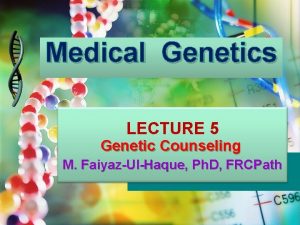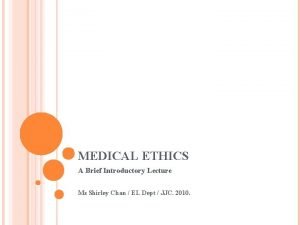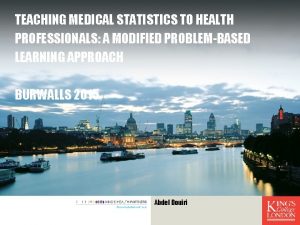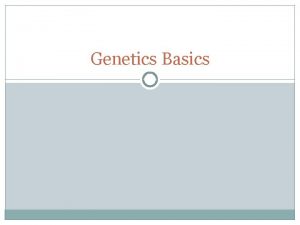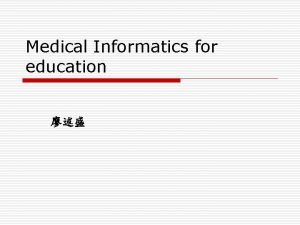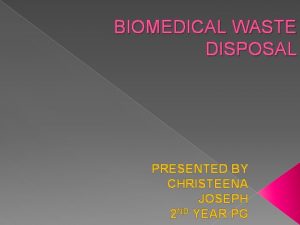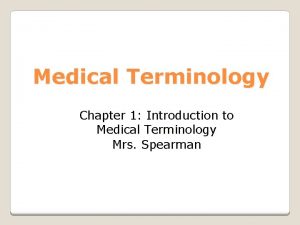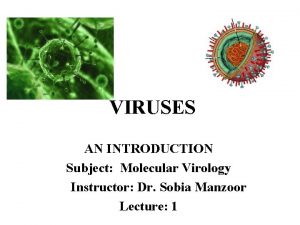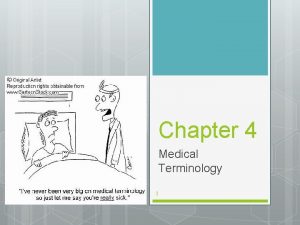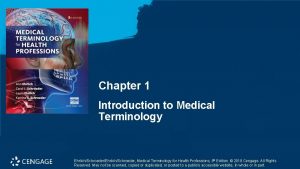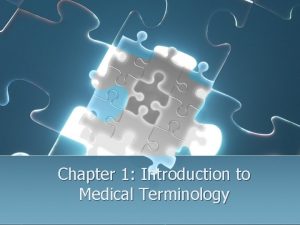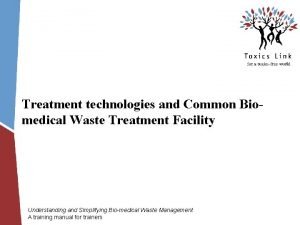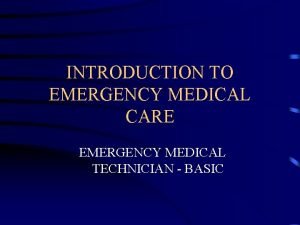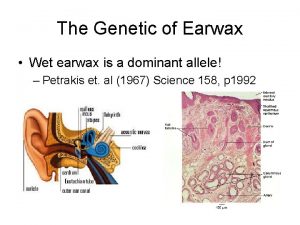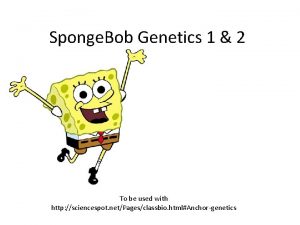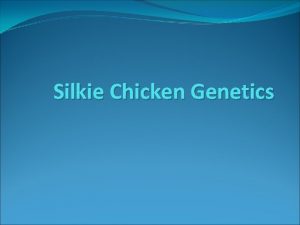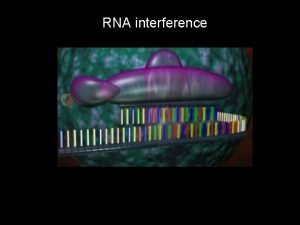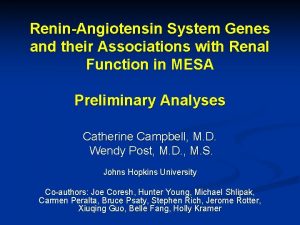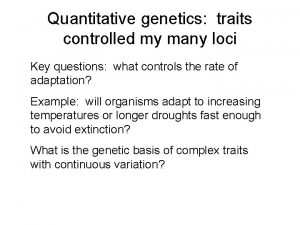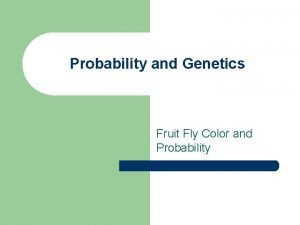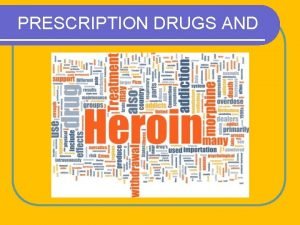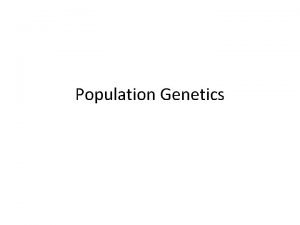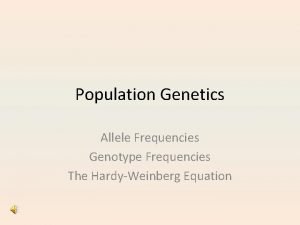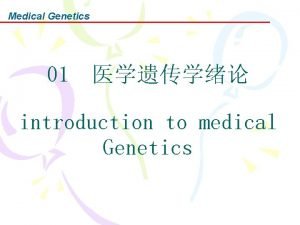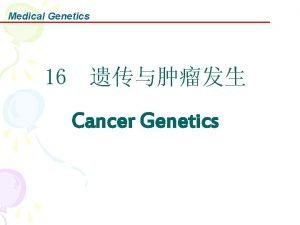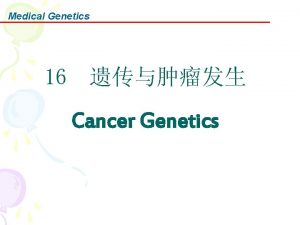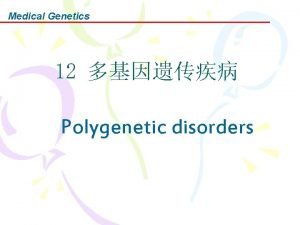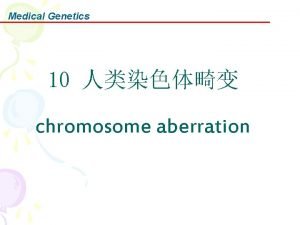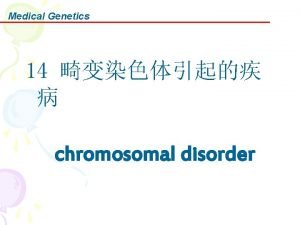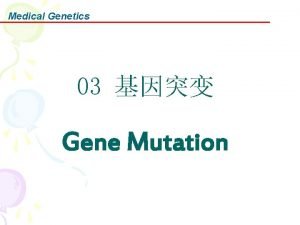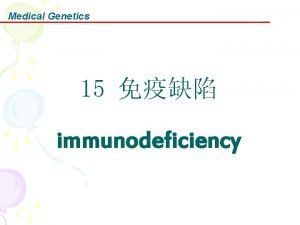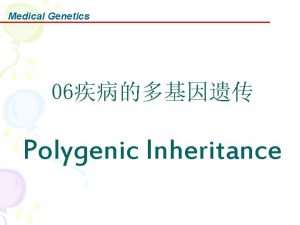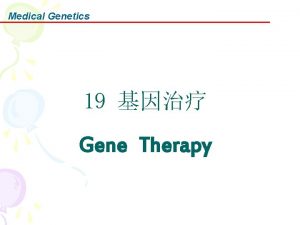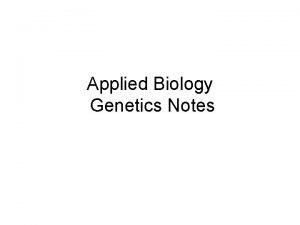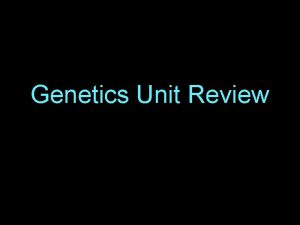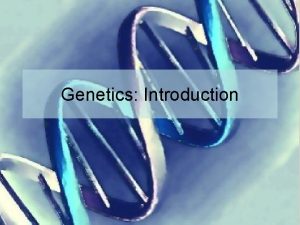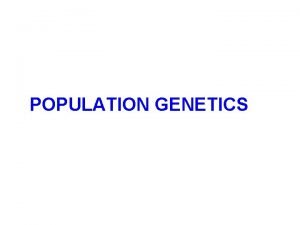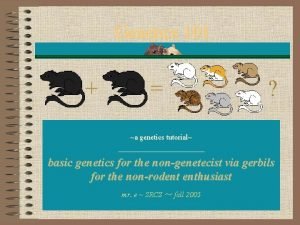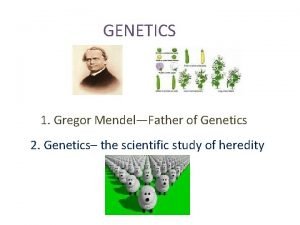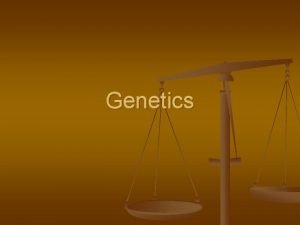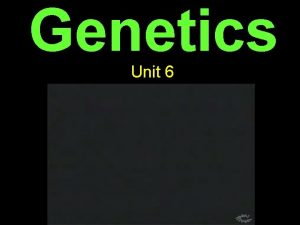Medical Genetics MVI851 Lecture 1 Introduction to Genetics











































- Slides: 43

Medical Genetics MVI-851 Lecture 1

Introduction to Genetics • GENETICS – branch of biology that deals with heredity and variation of organisms. • Chromosomes carry the hereditary information (genes) • Arrangement of nucleotides in DNA • DNA RNA Proteins

What is Medical Genetics? human genetics: The science of variation and heredity in human beings.

What is Medical Genetics? human genetics

Genetic Disorders : disorders caused wholly or partly by genetic factors.

What is Medical Genetics? Medical Genetics : Medical genetics deals with human genetic variation of medical significance. Major recognized areas of specialization are the study of chromosomes, and the structure and function of individual genes.

What is Medical Genetics? Clinical Genetics the application to diagnosis and patient care

• Chromosomes (and genes) occur in pairs Homologous Chromosomes • New combinations of genes occur in sexual reproduction • Fertilization from two parents

Genetics terms you need to know: • Gene – a unit of heredity; a section of DNA sequence encoding a single protein • Genome – the entire set of genes in an organism • Alleles – two genes that occupy the same position on homologous chromosomes and that cover the same trait (like ‘flavors’ of a trait). • Locus – a fixed location on a strand of DNA where a gene or one of its alleles is located.

• Homozygous – having identical genes (one from each parent) for a particular characteristic. • Heterozygous – having two different genes for a particular characteristic. • Dominant – the allele of a gene that masks or suppresses the expression of an alternate allele; the trait appears in the heterozygous condition. • Recessive – an allele that is masked by a dominant allele; does not appear in the heterozygous condition, only in homozygous.

• Genotype – the genetic makeup of an organisms • Phenotype – the physical appearance of an organism (Genotype + environment) • Monohybrid cross: a genetic cross involving a single pair of genes (one trait); parents differ by a single trait. • P = Parental generation • F 1 = First filial generation; offspring from a genetic cross. • F 2 = Second filial generation of a genetic cross

What is Medical Genetics? albinism diagnosis There are three basic types of melanin: eumelanin (Brown n Black), pheomelanin (red), and neuromelanin Sickle cell anemia-hemoglobin-Beta gene found on chromosome 11

What is Medical Genetics? Molecular Diagnosis • • Physical examination Personal medical history Family medical history Biochemical tests (chromosomal karyotype) Gel electrophoresis

What is Medical Genetics? Prevention Prenatal diagnosis is a way for your doctor to determine, before birth, whether your fetus has a problem such as Down syndrome. Amniocentesis and chorionic villus sampling (CVS) are tests that help find genetic disorders before birth.

What we can get from chromosomal analysis? 15

What is Medical Genetics? Therapy Consult

Genetic disease A. What is genetic disorder? A genetic disorder is a disease that is caused by an abnormality in an individual’s DNA. Abnormalities can range from a small mutation in a single gene to the addition or subtraction of an entire chromosome or set of chromosomes.

Genetic disease B. Characteristics of genetic disorders 1. congenital 2. mode of inheritance 3. population distribution 4. familial 5. infectious

Down syndrome (Trisomy 21) 47, XXY (extra chromosome ) Klinefelter sydrome albinism

Genetic disease B. Characteristics of genetic disorders 1. congenital 2. mode of inheritance (XX and XY) 3. population distribution (defective factor VIII, a clotting protein) 4. familial (A high level of the enzyme creatine kinase (CK) can indicate DMD) 5. infectious

Genetic disease human prion diseases genetic and infectious § § Acquired Genetic (PRNP gene) Heredity Sporadic It’s often estimated that human prion disease cases are 85% sporadic, 15% genetic and < 1% acquired Neuron : Vacuolar degeneration

Androgen insensitivity syndrome, AIS • Mechanism Caused by mutations of the gene encoding the androgen receptor. • symptoms A person with complete androgen insensitivity syndrome (CAIS) has a female external appearance, and suppressed menstruation.

Introduction-Disease and Genetics A. Disease caused by (or related to) environmental stress. Bird Flu (HFN 1) SARS H 1 N 1 Flu

Introduction-Disease and Genetics Down syndrome Trisomy of chromosome 21 Many of the common physical features Low IQ

Genetic disease C. Classification of Genetic Disorders 1. single-gene disorders 2. chromosome disorders 3. multifactorial disorders 4. somatic cell genetic disorders 5. mitochondrial disorders

Genetic disease C. Classification of Genetic Disorders 1. single-gene disorders 2. chromosome disorders 3. multifactorial disorders 4. somatic cell genetic disorders 5. mitochondrial disorders

Genetic disease Single-gene disorders result when a mutation causes the protein product of a single gene to be altered or missing.

Genetic disease C. Classification of Genetic Disorders 1. single-gene disorders 2. chromosome disorders 3. multifactorial disorders 4. somatic cell genetic disorders 5. mitochondrial disorders

In chromosome disorders, entire chromosomes, or large segments of them, are missing, duplicated, or otherwise altered.

The Philadelphia Chromosome found in patients with Chronic Myeloid Leukemia causes a fusion protein to be made from a combination of genes on chromosomes 9 and 22. 30

Translocation Involved in Burkitt’s Lymphoma 31

Patau syndrome Trisomy 13 -- the presence of an extra (third) chromosome 13 in all of the cells.

Symptoms • Physical characteristics • Organ defects • Mental retardation

physical characteristics small eyes cleft lips and nose low-set ears

physical characteristics rocker foot

Organ defects • heart defects • spinal defects

• abnormal genitalia • gastrointestinal • polycystic kidney disease

mental retardation • Incomplete brain development • Low IQ

Ø 99%do not survive gestation and are spontaneously aborted Ø 82 -85% do not survive past 1 month of age, 85% do not survive past 1 year of age

Diagnosis &Treatment • Diagnosis: chromosome analysis

Genetic disease C. Classification of Genetic Disorders 1. single-gene disorders 2. chromosome disorders 3. multifactorial disorders (Multifactorial disorders result from mutations in multiple genes, often coupled with environmental causes) 4. somatic cell genetic disorders (result from the altered genetic materials in somatic cells) 5. mitochondrial disorders

Multiple genes are missing as a result of this deletion, and each may contribute to the symptoms of the disorder. One of the deleted genes known to be involved is TERT (telomerase reverse transcriptase). This gene is important during cell division because it helps to keep the tips of chromosomes (telomeres) in tact.

Genetic disease C. Classification of Genetic Disorders 1. single-gene disorders 2. chromosome disorders 3. multifactorial disorders 4. somatic cell genetic disorders 5. mitochondrial disorders
 Medical genetics lecture
Medical genetics lecture 01:640:244 lecture notes - lecture 15: plat, idah, farad
01:640:244 lecture notes - lecture 15: plat, idah, farad C5oh name
C5oh name Medical ethics lecture
Medical ethics lecture Quadrant streak
Quadrant streak Medical statistics lecture
Medical statistics lecture Aim of health psychology
Aim of health psychology Heterozygous b blood type
Heterozygous b blood type Introduction to biochemistry lecture notes
Introduction to biochemistry lecture notes Introduction to psychology lecture
Introduction to psychology lecture Introduction to algorithms lecture notes
Introduction to algorithms lecture notes California medical license for foreign medical graduates
California medical license for foreign medical graduates Greater baltimore medical center medical records
Greater baltimore medical center medical records Difference between medical report and medical certificate
Difference between medical report and medical certificate Torrance memorial human resources
Torrance memorial human resources Cartersville medical center medical records
Cartersville medical center medical records Introduction to medical informatics
Introduction to medical informatics Chapter 1 matching medical terminology
Chapter 1 matching medical terminology Hospital waste
Hospital waste Introduction to medical terminology chapter 1
Introduction to medical terminology chapter 1 Introduction to emergency medical care
Introduction to emergency medical care Introduction to medical virology
Introduction to medical virology Combining form for rib
Combining form for rib Introduction to medical terminology chapter 1
Introduction to medical terminology chapter 1 Introduction to medical ethics
Introduction to medical ethics Chapter 1 introduction to medical terminology
Chapter 1 introduction to medical terminology Cbwtf full form
Cbwtf full form Biomedical waste management definition
Biomedical waste management definition Introduction to emergency medical care
Introduction to emergency medical care Introduction to emergency medical care
Introduction to emergency medical care Introduction to emergency medical care
Introduction to emergency medical care Introduction paragraph format
Introduction paragraph format Genetics yellow and blue make
Genetics yellow and blue make Earwax type genetics
Earwax type genetics Sponge bob genetics 2
Sponge bob genetics 2 Silkie chicken color genetics
Silkie chicken color genetics Section 1 meiosis
Section 1 meiosis %22ds-5%22%20development%20studio
%22ds-5%22%20development%20studio Genetics model
Genetics model Achillea millefolium
Achillea millefolium Probability in genetics
Probability in genetics Learn.genetics.utah/content/addiction/mouse
Learn.genetics.utah/content/addiction/mouse Population genetics
Population genetics Gene frequency
Gene frequency
